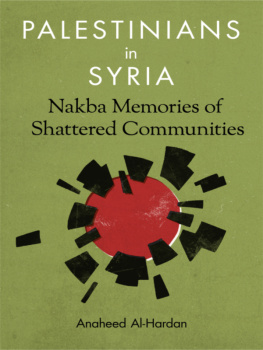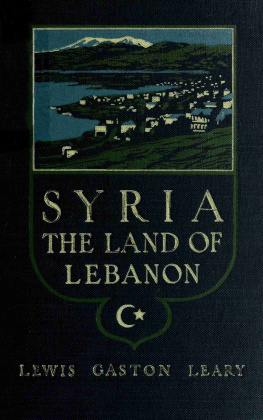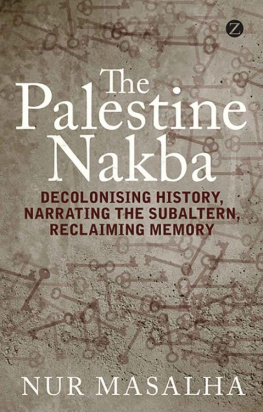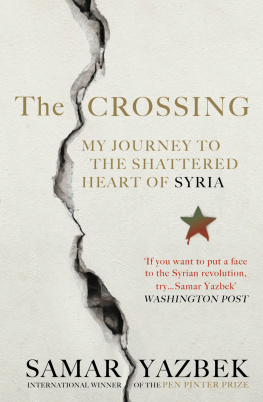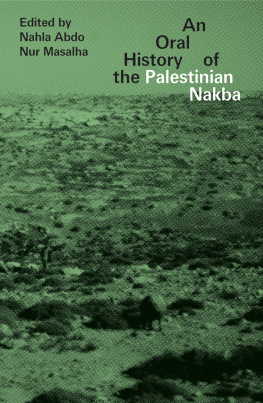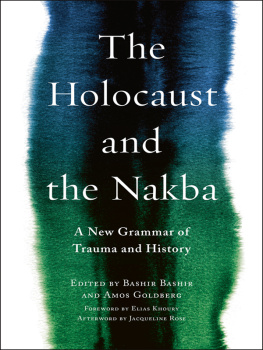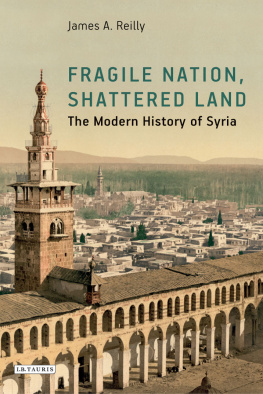PALESTINIANS IN SYRIA
PALESTINIANS IN SYRIA
NAKBA MEMORIES OF SHATTERED COMMUNITIES
ANAHEED AL-HARDAN
COLUMBIA UNIVERSITY PRESS NEW YORK
Columbia University Press
Publishers Since 1893
New York Chichester, West Sussex
cup.columbia.edu
Copyright 2016 Columbia University Press
All rights reserved
E-ISBN 978-0-231-54122-0
Library of Congress Cataloging-in-Publication Data
Names: Al-Hardan, Anaheed, author.
Title: Palestinians in Syria : Nakba memories of shattered communities / Anaheed Al-Hardan.
Description: New York : Columbia University Press, [2016] |
Includes bibliographical references and index.
Identifiers: LCCN 2015039971 | ISBN 9780231176361 (cloth : alk. paper) |
ISBN 9780231541220 (e-book)
Subjects: LCSH: Refugees, Palestinian ArabSyria. | Palestinian ArabsSyria. |
Arab-Israeli conflict1993
Classification: LCC HV640.5.P36 A38 2016 | DDC 956.04/21dc23
LC record available at http://lccn.loc.gov/2015039971
A Columbia University Press E-book.
CUP would be pleased to hear about your reading experience with this e-book at .
Cover design: Martin Hinze
References to Internet Web sites (URLs) were accurate at the time of writing. Neither the author nor Columbia University Press is responsible for URLs that may have expired or changed since the articles were prepared.
This book is dedicated to Syria and its people.
CONTENTS
A ll Arabic to English translations in the book are my own unless stated otherwise. I have followed a simplified version of the American Library AssociationLibrary of Congress Romanization Table for the transliteration of modern standard Arabic sources. This means that with the exception of the use of apostrophes to indicate ayn () and hamza (), I have not used diacritics to indicate non-Roman letters. Similarly, with a few exceptions, I have generally not added short vowels at the end of words, doubled consonants to indicate al-shada in initial letters, or transliterated the final ha. I have also attempted to bring two Arabic words into common English-language use: Nakba (1948 catastrophe) and Naksa (1967 setback).
In regard to common words and names of individuals and organizations, I have used common English transliterations when available. This includes an authors name as per its preexisting English transliteration when citing their English language work. I have also used the lowercase for the definite article al- with the exception of the uppercase Al- when referring to the last name of an author whose work is available in English with an uppercase.
I have followed the Walid Khalidiedited All That Remains: The Palestinian Villages Occupied and Depopulated by Israeli in 1948 (Institute for Palestine Studies, Washington, DC, 1992) for the transliteration of the names of destroyed Palestinian villages. The only exception is the transliteration of the names of two villages whose names were pronounced differently by its people and their descendants (Akrad al-Baqqara and Akrad al-Ghannama). I have also followed the website of the United Nations Relief and Works Agency for Palestine Refugees in the Near East for the transliteration of the names of Palestinian refugee camps in Syria.
B eginnings, the late Edward Said (1997, 5) wrote, are the first step in the willful production of meaning. One of the beginnings of the research project that underpins this book is in the Nakba, or catastrophe, that resulted from the establishment of the state of Israel on Palestine in May 1948. This catastrophe saw the dispossession of more than half of historic Palestines population, some 800,000 people, the overwhelming majority between March and October 1948. This annihilation of at least four-fifths of Palestinian society as it had once existed in the conquered territories, which unfolded from the end of 1947 to the beginning of 1949 and afterward, took place alongside the obliteration of at least 531 villages and eleven urban quarters (Pappe 2006a).
Reclaiming and claiming history, Indigenous scholars have argued, is an essential part of decolonization (Smith 2012). The Nakba, however, is not only a historical event. It is today also a structure of Israeli settler-colonial rule in historic Palestine (Salamanca et al. 2012), one based on settler-colonialisms logic of the elimination of the Indigenous population (Wolfe 2006). Examining memories that resulted from the Nakba is therefore not about taking part in a mourning of a second order (Chow 2008). It is about acknowledgment and accountability for the atrocities and enforced statelessness that accompanied the establishment of the state of Israel in 1948. This includes the decolonization of an ongoing violent system of settler-colonial domination (or total exclusion, in the case of the Palestinians expelled in 1948) that Israel has established over all Palestinian lives since 1948 (Salamanca et al. 2012; F. Sayegh 2012).
This geopolitical formulation of the research projects beginnings is intersected by yet another one, the body-political location of the researcher (Mignolo 2011). Setting out to search for memories of the Nakba was a deeply personal endeavor. I myself am a granddaughter of the Nakba, and my family, like all Palestinian families expelled in 1948, has a history of experiencing a violent dispossession. This dispossession unfolded from Umm al-Zinat, a Mount Carmel village outside Haifa that was subsequently erased from the face of the earth, and with it our communities existence in Palestine (Al-Hardan 2008; al-Asad 1990). The story of the Nakba for my family, as with most Palestinian families turned refugees now unto the fourth and fifth generation, did not simply end in 1948. The enforced statelessness and lack of implementation of our right of return to what became the state of Israel resulted in repeated dispossessions and deportations. The latest of these has been encapsulated by the fate of the Palestinian refugee community in Iraq following the US invasion and destruction of that country (Al-Hardan 2009; al-Asad 1999).
The body and the political in the body-political location of researchers do not necessarily always correspond. Closely tied to these ontological beginnings are therefore the epistemic and the structural locations of the researcher as beginnings. In February 2008, I traveled to Syria from Ireland, guided by a situated knowledge (Haraway 1991, 183201) of the Nakba as central to Palestinians whose families were made refugees in 1948. The research was methodologically inspired by radical and black feminists, as well as Indigenous and decolonial theorists and activists. It was informed by theory based on everyday lived experiences, the researcher as part of, and not separate to, her research and knowledge claims, and research communities as places of conversation rather than discovery (Collins 2008; Haraway 1997; Smith 2012; Stanley and Wise 1993).
I was therefore thinking against normative research epistemologies, which have historically and politically been constituted through the European colonizers will to power and knowledge and this wills conquered others (Dussel 2000; Moreton-Robinson 2004). This meant that I also had to unlearn their conceptual categories. Not being a member of the Palestinian community in Syria, I came to learn that my preoccupation with such notions as insiders/outsiders overlooked the coloniality of power in the world (Quijano 2002). Also overlooked was the impact this had on the structural relations of power in the field, constructed as a site of research, as well as on research communities understood as comprising informants. Put another way, this is yet another beginning, one in which the body-political location of the researcher is realized within structural relations that are part of the coloniality of global power in the academy and in the world at large (Grosfoguel 2011).


